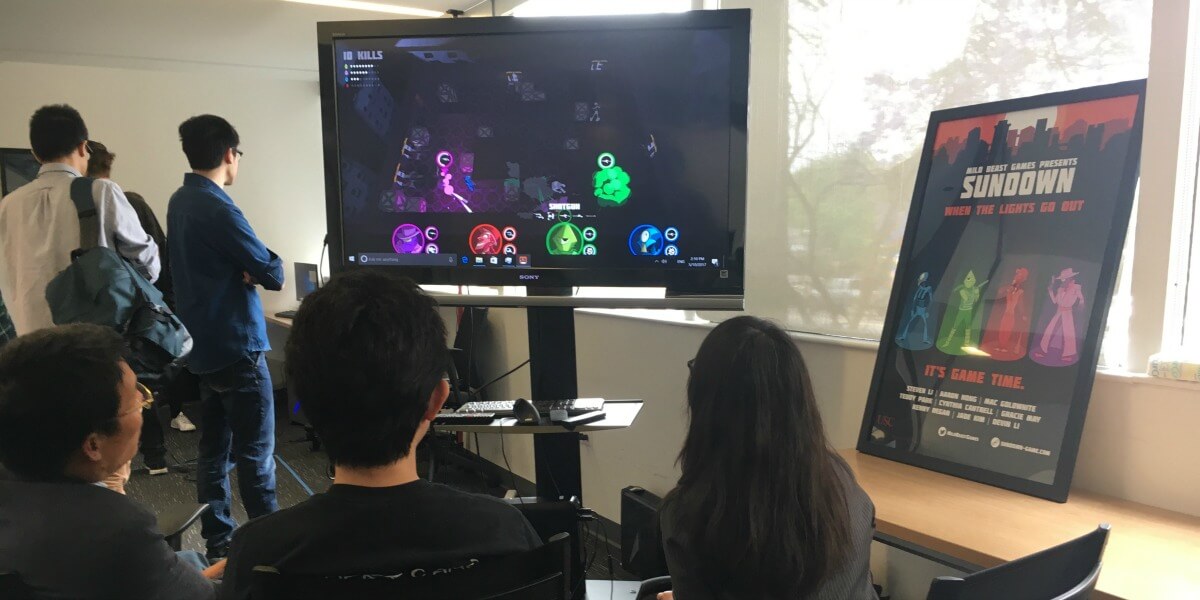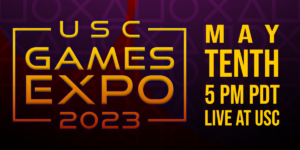
Students at the GamePipe Laboratory showcase play “Sundown” Photo / Tiana Lowe
Of the many superlatives USC can claim, few stand as economically, intellectually and prestigiously significant as USC Games — the number one video game programming curriculum in the world. Recognized as one of the top game design programs in North America by the Princeton Review, USC Games represents an exciting collaboration between the School of Cinematic Arts’ Interactive Media & Games Division and the USC Viterbi School of Engineering’s Department of Computer Science. Both the nationally premier undergraduate and graduate programs were on full display at May’s Demo Day at the USC School of Cinematic Arts and at GamePipe Laboratory Spring Showcase.
First was the GamePipe Lab Showcase, a display of mostly graduate level work championed by Michael Zyda, professor of engineering practice in the USC Department of Computer Science and GamePipe’s founding director.
Zyda estimates that games produced by GamePipe alumni have been played hundreds of millions of times by people around the world. It all makes sense upon the briefest observation of Zyda’s students.
“2,000 students have graduated from the GamePipe Laboratory since its inception,” Zyda said. “We, as an institution, have dominated an industry which generates billions of dollars into the U.S. economy annually.”
Here are just some of the games we played at both events.
Threshold
A team of just a dozen crafted Threshold, an immersive virtual reality survival game complete with monsters, romantic clues and red herrings. While Matthew Krumlauf, the game’s lead, may “not technically be a USC student,” he formed his team in the hallways of USC Viterbi while taking classes with the likes of Alex Wang, the game’s lead programmer and a graduate student in the Department of Computer Science.
“It shows that it’s a unique opportunity,” Krumlauf said. “When I first thought of Threshold, I knew that USC had the only possible teammates to curate the idea into something real.”
Sundown
Theodore Park, ’17 computer science, concurred. Sundown, a game that underwent four years of development at GamePipe will soon reach the mass market.
“I originally worked on Sundown for a class, and now it’s being released commercially,” revealed Park who said the platform and release dates are under wraps. Park is just one of the dozens that GamePipe churns out to the gaming industry annually.
“We’re the best in the world in large part because we have the best connections,” Zyda said. “USC alumni comprise a major creative power advancing the gaming industry today.”
The basis of the university’s prestige rests upon the undergraduate USC Games program, a product of both Viterbi’s Department of Computer Science and the School of Cinematic Arts’ Interactive Media and Games Division. Just a mile away from the GamePipe Lab and a few hours later, USC Games’ Demo Day broke out in full force, showcasing dozens of other games across a myriad of platforms, ready for users across all skill levels, all across the country.
The multiplayer “Skyshot” to the 2.5 D platformer “Second Nature” spanned Demo Day, a demonstration diverse in every technical and aesthetic concept.
Skyshot
Skyshot is part of the Esport movement currently taking over the world. Developed by Eu-Ann Liu, ’17 B.S. computer science, it’s a frenetic multiplayer ball game that combines parkour movement with grappling hooks. Players swing around the arena to pursue the ball, outmaneuver opponents, and score.
Second Nature
“Games are not something that can be made in isolation,” said Aaron Cheney, ’17 B.S. computer science, the Game Director and Lead Engineer of the aforementioned Second Nature. “We began with just two people and now has a team of 25 across disciplines. It’s the only way it works.”
 A co-op only platformer designed for two players, Second Nature is a gorgeous, painterly game that really tests your ability to quickly solve puzzles. Take up arms as Terus and Zeph, two orphaned guardians of the planet Lura who fight to conquer a blight-infested landscape and restore vitality to their home. Form an unstoppable duo as you explore the lush, alien landscapes of Lura, overcome obstacles as a team, and master asymmetric co-op mechanics to reclaim your homeland.
A co-op only platformer designed for two players, Second Nature is a gorgeous, painterly game that really tests your ability to quickly solve puzzles. Take up arms as Terus and Zeph, two orphaned guardians of the planet Lura who fight to conquer a blight-infested landscape and restore vitality to their home. Form an unstoppable duo as you explore the lush, alien landscapes of Lura, overcome obstacles as a team, and master asymmetric co-op mechanics to reclaim your homeland.
It’s exactly the kind of couch game you remember playing with your friends, reminiscent of Super Meat Boy.
“We built Second Nature because of our love for co-op games and beautiful platformers,” wrote the game developers on the game’s site. “Some of our favorite childhood memories can be traced back to games we played with friends and siblings in the classic couch co-op setting.”
While other design programs focus on doubling down on code or design or storyline, USC highlights the importance of the two most vital forms of collaboration: between disciplines and between academia and the private sector.
“USC Games is a unique program that shows what can be done when you’re willing to break down disciplinary boundaries, said Guarav Sukhatme, chair of the Department of Computer Science. “We’re proud of our students’ achievements – they amaze us with their creativity and passion every year.”
“The games showcased at this year’s Demo Day Class of 2017 festival are perfect examples of the creativity, skill, and artistry of video game design our students show every year,” wrote Tracy Fullerton, chair of SCA Interactive Media & Games Division and Director of the USC Game Innovation Lab.
“These games are a message to the video game industry and public that innovation, teamwork, and the next generation of great video game makers are here at USC Games.”
GamePipe Lab 2017 Showcase game trailers
GamePipe Lab 2017 Showcase (all games listed)
USC Games Demo Day 2017 Showcase
Published on May 24th, 2017
Last updated on August 30th, 2019












